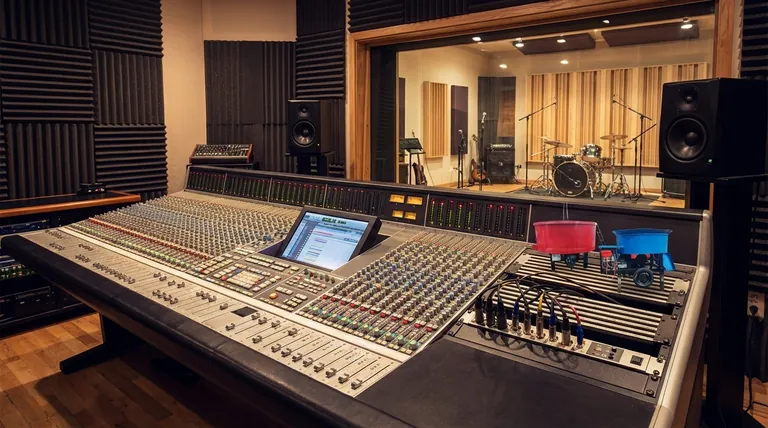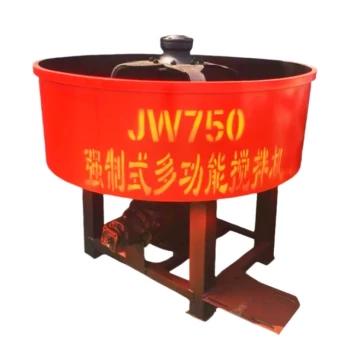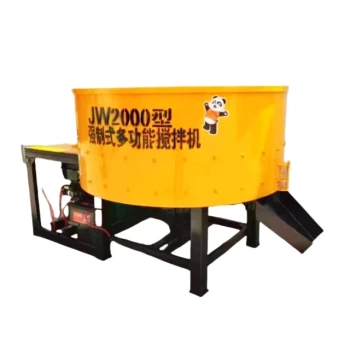At its core, a mixing machine works by taking multiple audio signals, such as microphones and instruments, and blending them together into a single, cohesive output. This combined signal is then sent from the mixer's 'main output' to a destination like an amplifier, PA system, or recording device.
A mixer isn't simply a device for combining sounds. It is a precise control system that allows you to individually shape the volume, tone, and stereo position of every source before they are blended into the final mix.

The Journey of a Signal: From Input to Output
To understand how a mixer works, it's best to follow the path a single audio signal takes from the moment it enters the device to the moment it leaves. This path is known as the "signal chain."
The Input and Gain Stage
Every sound starts by entering the mixer through an input jack, typically via an XLR or 1/4" cable.
The first control it meets is the gain or trim knob. This crucial first step sets the initial input level, ensuring the signal is strong enough to work with but not so loud that it distorts.
The Channel Strip: Shaping the Sound
Once the level is set, the signal flows down a "channel strip," which is a dedicated column of controls for that single input.
The most important controls here are the Equalizer (EQ), which adjusts the tonal balance (bass, mids, treble), and the channel fader, a slider that controls the volume of that specific channel in the overall mix.
Other common controls include panning, which places the sound in the left or right side of the stereo field.
The Mix Bus: Blending the Sources
As you adjust the fader for each individual channel, you are deciding how much of that signal to send to the master "mix bus."
The mix bus is the central point where all the individual, shaped signals from each channel strip are finally combined into one stereo signal.
The Master Section: The Final Output
The combined signal from the mix bus then travels to the master section. Here, a final master fader controls the overall volume of the entire mix.
This is the last point of control before the audio is sent out of the main outputs and on to the speakers or recording interface.
Understanding the Trade-offs: Analog vs. Digital
The fundamental process of mixing is the same everywhere, but the technology used creates a key trade-off between two main types of mixers.
The Analog Mixer: Direct and Tactile
Analog mixers process audio as a continuous electrical signal. Each knob and fader physically alters the voltage of the sound wave.
This provides immediate, hands-on control with zero latency, but features are often limited to what is physically built into the hardware.
The Digital Mixer: Flexible and Powerful
Digital mixers first convert the incoming analog audio into digital information (ones and zeros). All processing, like EQ and effects, is then handled by an internal computer.
This allows for incredible flexibility, including saving and recalling entire mixes, extensive built-in effects, and remote control. The trade-off can be a steeper learning curve and a less direct, tactile feel.
Matching the Mixer to Your Goal
Choosing the right mixer depends entirely on the complexity of your task.
- If your primary focus is a small live performance or podcast: A compact analog mixer with 4-8 channels provides simple, reliable control where you need it most.
- If your primary focus is recording a full band: A larger digital mixer or an audio interface with built-in mixing software offers the channel count and flexibility needed for a multi-track project.
- If your primary focus is managing a large live event: A full-featured digital console is essential for its ability to handle many inputs, save scenes, and offer advanced routing options.
By understanding this fundamental workflow, you can confidently control any mixer, from the simplest compact unit to a large-format professional console.
Summary Table:
| Mixer Type | Best For | Key Features |
|---|---|---|
| Analog Mixer | Small live performances, podcasts | Tactile controls, simple operation, zero latency |
| Digital Mixer | Recording bands, large live events | Save/recall mixes, built-in effects, advanced routing |
Ready to find the perfect mixing solution for your project?
At GARLWAY, we specialize in providing robust and reliable machinery for demanding environments. While our expertise is in construction equipment like winches, concrete mixers, and batching plants, we understand the importance of precision and control in any industry.
If you're a contractor or construction company looking for powerful and dependable mixing machinery for your site, we can help. Contact our experts today to discuss your specific needs and discover how GARLWAY's equipment can bring reliability and efficiency to your operations.
Visual Guide

Related Products
- Ready Mixer Machine for Construction Ready Mix Machinery
- Portable Concrete Mixer Machine Equipment for Mixing Concrete
- Commercial Construction Mixer Machine for Soil Cement Mixing Concrete
- Commercial Electric Concrete Mixer Machine HZS 50 Small Batch Plant for Sale
- JZC500 Large Cement Mixer Machine Price for Concrete Mix
People Also Ask
- What is the average lifespan of a concrete mixer? Maximize Your Equipment's Lifespan & ROI
- What was significant about Roscoe Lee's 1934 concrete mixer design? Pioneering Modular Construction Equipment
- Which type of projects require a concrete mixer? Essential Guide for Construction Pros
- When was the first concrete mixer developed and by whom? Discover the 1900 Breakthrough
- Can a concrete mixer be used for mortar? Understanding the trade-offs for your project



















